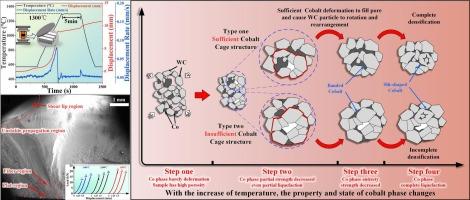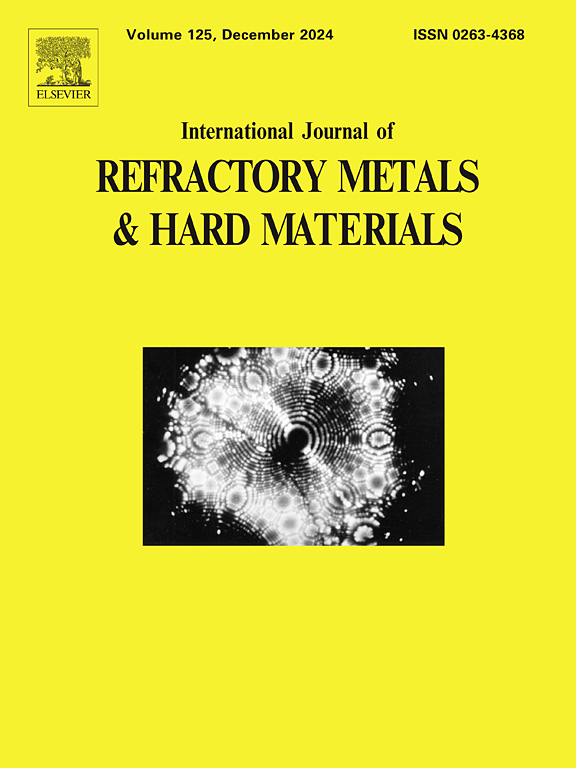通过火花等离子烧结制备 WC-Co 硬质合金:微观结构演变、力学性能和致密化机制
IF 4.2
2区 材料科学
Q2 MATERIALS SCIENCE, MULTIDISCIPLINARY
International Journal of Refractory Metals & Hard Materials
Pub Date : 2024-11-15
DOI:10.1016/j.ijrmhm.2024.106964
引用次数: 0
摘要
本研究利用火花等离子烧结法(SPS)制造细粒度的硬质合金,并采用正交实验设计考察了保温温度(1100 °C、1200 °C、1300 °C)和保温时间(5、10 和 15 分钟)对 WC-10Co 硬质合金试样性能的影响。与传统烧结方法相比,这项研究在较低温度和较短时间内制备出了综合性能更高的试样。具体来说,在保温温度为 1300 ℃、保温时间为 5 分钟的条件下,制得的试样密度为 14.64 g/cm3,硬度为 91.29 HRA,断裂韧性为 16.39 MPa-m/½,横向断裂强度为 2398 MPa。微观结构分析表明,随着保温温度的升高,试样中的钴相从最初的粉末状转变为带状钴,随后又转变为缝隙状钴。研究发现,带状钴的存在有效地阻碍了裂纹的扩展,而狭缝状钴则更有效地阻止了裂纹的产生,从而影响了试样的整体性能。通过分析烧结曲线和微观结构,阐明了 WC-Co 硬质合金在 SPS 烧结过程中的致密化机制。研究认为,Co 相的状态变化对烧结材料的致密化行为、最终微观结构和性能起着重要作用。这些发现为理解和优化 SPS 工艺提供了宝贵的见解。本文章由计算机程序翻译,如有差异,请以英文原文为准。

Preparation of WC-Co cemented carbide by spark plasma sintering: Microstructure evolution, mechanical properties and densification mechanism
In this study, Spark Plasma Sintering (SPS) was utilized to fabricate fine-grained cemented carbides, and an orthogonal experimental design was employed to examine the influence of holding temperature (1100 °C, 1200 °C, 1300 °C) and holding time (5, 10, and 15 min) on the performance of WC-10Co cemented carbide specimens. Compared with conventional sintering methods, this work achieved the production of samples with enhanced overall performance at lower temperatures and shorter durations. Specifically, under the conditions of a holding temperature of 1300 °C and a holding time of 5 min, the resulting specimens exhibited a density of 14.64 g/cm3, a hardness of 91.29 HRA, a fracture toughness of 16.39 MPa·m½, and a transverse rupture strength of 2398 MPa. The microstructural analysis revealed that as the holding temperature increased, the Co phase in the specimens underwent a transformation from its initial powder form to banded cobalt and subsequently to slit-shaped cobalt. It was found that the presence of banded cobalt effectively hinders crack propagation, whereas slit-shaped cobalt is more effective in preventing crack initiation, thus impacting the overall performance of the specimens. By analyzing the sintering curves and microstructures, the densification mechanisms during SPS sintering of WC-Co cemented carbides were elucidated. The study concluded that the state changes of the Co phase play a significant role in the densification behavior, final microstructure, and properties of the sintered material. These findings offer valuable insights for understanding and optimizing the SPS process.
求助全文
通过发布文献求助,成功后即可免费获取论文全文。
去求助
来源期刊
CiteScore
7.00
自引率
13.90%
发文量
236
审稿时长
35 days
期刊介绍:
The International Journal of Refractory Metals and Hard Materials (IJRMHM) publishes original research articles concerned with all aspects of refractory metals and hard materials. Refractory metals are defined as metals with melting points higher than 1800 °C. These are tungsten, molybdenum, chromium, tantalum, niobium, hafnium, and rhenium, as well as many compounds and alloys based thereupon. Hard materials that are included in the scope of this journal are defined as materials with hardness values higher than 1000 kg/mm2, primarily intended for applications as manufacturing tools or wear resistant components in mechanical systems. Thus they encompass carbides, nitrides and borides of metals, and related compounds. A special focus of this journal is put on the family of hardmetals, which is also known as cemented tungsten carbide, and cermets which are based on titanium carbide and carbonitrides with or without a metal binder. Ceramics and superhard materials including diamond and cubic boron nitride may also be accepted provided the subject material is presented as hard materials as defined above.

 求助内容:
求助内容: 应助结果提醒方式:
应助结果提醒方式:


